Content for TS 23.434 Word version: 19.3.0
0…
4…
5
6…
6.4…
6.5…
6.5.3…
7…
8…
8.2.2…
9…
9.3…
9.3.2.21…
9.3.3…
9.3.6…
9.3.11…
9.3.13…
9.3.14…
9.4…
9.4.6…
9.5…
10…
10.3…
10.3.2.22…
10.3.3…
10.3.7…
10.3.10…
10.4…
11…
11.3…
11.3.3…
11.4…
12…
12.3…
13…
14…
14.2.2.2…
14.3…
14.3.2.20…
14.3.2.40…
14.3.3…
14.3.3.3…
14.3.4…
14.3.4.6
14.3.4.7…
14.3.4A…
14.3.4A.3…
14.3.4A.4…
14.3.4A.6…
14.3.4A.8…
14.3.4A.9…
14.3.4A.10…
14.3.5…
14.3.6…
14.3.9…
14.3.12…
14.4…
15…
16…
17…
18…
A
B…
12.3 Procedures and information flows for identity management
12.3.1 General
12.3.2 Information flows
12.3.2.1 VAL server provisioning request
12.3.2.2 VAL server provisioning response
12.3.2.3 Update VAL server provisioning request
12.3.2.4 Update VAL server provisioning response
12.3.2.5 Get VAL server provisioning request
12.3.2.6 Get VAL server provisioning response
12.3.2.7 Delete VAL server provisioning request
12.3.2.8 Delete VAL server provisioning response
12.3.3 General user authentication and authorization for VAL services
12.3.3.1 General
12.3.3.2 Primary VAL system
12.3.3.3 Interconnection partner VAL system
12.3.4 VAL server provisioning for identity management service
12.3.4.1 General
12.3.4.2 Procedure
12.3.4.3 Update VAL server provisioning procedure
12.3.4.4 Get VAL server provisioning procedure
12.3.4.5 Delete VAL server provisioning procedure
12.4 SEAL APIs for identity management
12.4.1 General
12.4.3 SS_IdmParameterProvisioning API
12.4.3.1 General
12.4.3.2 Provide_Configuration operation
12.4.3.3 Update_Configuration operation
12.4.3.4 Get_Configuration operation
12.4.3.5 Delete_Configuration operation
...
...
12.3 Procedures and information flows for identity management p. 164
12.3.1 General p. 164
The procedures related to the identity management are described in the following subclauses.
12.3.2 Information flows p. 164
12.3.2.1 VAL server provisioning request |R18| p. 164
Table 12.3.2.1-1 describes the information flow from the VAL server to the identity management server for providing provisioning configuration.
| Information element | Status | Description |
|---|---|---|
| Requester Identity | M | The identity of the VAL server performing the request. |
| List of VAL service specific information | M | Provides the list of VAL service specific information |
| > VAL service ID | M | Identify of the VAL service for which the configuration information is provided. |
| > identity list | M | Identify list of VAL users for the specific VAL service (i.e. VAL User IDs or VAL UE IDs) |
12.3.2.2 VAL server provisioning response |R18| p. 164
Table 12.3.2.2-1 describes the information flow from the identity management server to the VAL server as a response for providing provisioning configuration.
| Information element | Status | Description |
|---|---|---|
| Result | M | Indicates success or failure of the request |
12.3.2.3 Update VAL server provisioning request |R18| p. 164
Table 12.3.2.3-1 describes the information flow from the VAL server to the identity management server for updating provisioning configuration.
| Information element | Status | Description |
|---|---|---|
| Requester Identity (see NOTE) | M | The identity of the VAL server performing the request. |
| List of VAL service specific information | M | Provides the list of VAL service specific information. |
| > VAL service ID | M | Identify of the VAL service for which the configuration information is to be updated. |
| > identity list | O | Identify list of VAL users for the specific VAL service (i.e. VAL User IDs or VAL UE IDs). |
|
NOTE:
The IE shall not be updated by the VAL server.
|
||
12.3.2.4 Update VAL server provisioning response |R18| p. 165
Table 12.3.2.4-1 describes the information flow from the identity management server to the VAL server as a response for updating provisioning configuration.
| Information element | Status | Description |
|---|---|---|
| Result | M | Indicates success or failure of the request |
12.3.2.5 Get VAL server provisioning request |R18| p. 165
Table 12.3.2.5-1 describes the information flow from the VAL server to the identity management server to get provisioning configuration.
| Information element | Status | Description |
|---|---|---|
| Requester Identity | M | The identity of the VAL server performing the request. |
12.3.2.6 Get VAL server provisioning response |R18| p. 165
Table 12.3.2.6-1 describes the information flow from the identity management server to the VAL server as a response to get provisioning configuration.
| Information element | Status | Description |
|---|---|---|
| Result | M | Indicates success or failure of the request. |
| List of VAL service specific information (NOTE 1) | M | Provides the list of VAL service specific information. |
| > VAL service ID | M | Identify of the VAL service for which the configuration information is provided. |
| > identity list | M | Identify list of VAL users for the specific VAL service (i.e. VAL User IDs or VAL UE IDs). |
|
NOTE 1:
This IE is included only for success response.
|
||
12.3.2.7 Delete VAL server provisioning request |R18| p. 165
Table 12.3.2.7-1 describes the information flow from the VAL server to the identity management server for deleting provisioning configuration.
| Information element | Status | Description |
|---|---|---|
| Requester Identity | M | The identity of the VAL server performing the request. |
12.3.2.8 Delete VAL server provisioning response |R18| p. 166
Table 12.3.2.8-1 describes the information flow from the identity management server to the VAL server as a response for deleting provisioning configuration.
| Information element | Status | Description |
|---|---|---|
| Result | M | Indicates success or failure of the request. |
12.3.3 General user authentication and authorization for VAL services p. 166
12.3.3.1 General p. 166
The high level user authentication and authorization procedure is described in the following subclause.
12.3.3.2 Primary VAL system p. 166
Figure 12.3.3.2-1 is a high level user authentication and authorization flow.
The user authentication process shown in Figure 12.3.3.2-1 may take place in some scenarios as a separate step independently from a SIP registration phase, for example if the SIP core is outside the domain of the VAL server.
A procedure for user authentication is illustrated in Figure 12.3.3.2-1. Other alternatives may be possible, such as authenticating the user within the SIP registration phase.
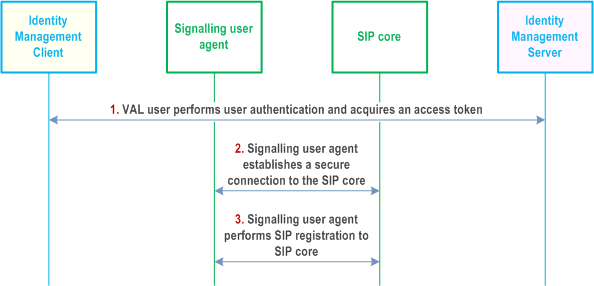
Step 1.
In this step the identity management client begins the user authorization procedure. The VAL user supplies the user credentials (e.g. biometrics, secureID, username/password) for verification with the identity management server. This step may occur before or after step 3. In a VAL system with multiple VAL services, a single user authentication as in step 1 can be used for multiple VAL service authorizations for the user.
Step 2.
The signalling user agent establishes a secure connection to the SIP core for the purpose of SIP level authentication and registration.
Step 3.
The signalling user agent completes the SIP level registration with the SIP core (and an optional third-party registration with the VAL service server(s)).
12.3.3.3 Interconnection partner VAL system p. 167
Where communications with a partner VAL system using interconnection are required, user authorization takes place in the serving VAL system of the VAL service user, using the VAL user service authorization procedure specified in subclauses 5.2.5 and 5.2.6 of TS 33.434.
12.3.4 VAL server provisioning for identity management service |R18| p. 167
12.3.4.1 General p. 167
The high level procedure for VAL server to provision required information to SEAL identity management server in order to support VAL user authentication is described in the following subclause.
12.3.4.2 Procedure p. 167
The procedure for VAL server to provision required information to SEAL identity management server in order to support VAL user authentication is illustrated in Figure 12.3.4.2-1.
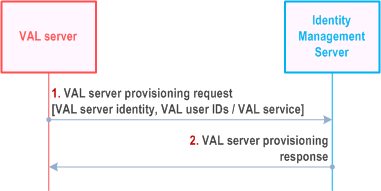
Step 1.
The VAL server sends a request message to identity management server to provision required information. The request message includes identity of the VAL server, security credentials of the VAL server, and service provider specific information like identity list per VAL service.
Step 2.
Upon receiving the request, the identity management server authorizes the request based on the security credentials provided in the request and considering the service level agreement between VAL service provider and SEAL service provider. If VAL server is authorized to use the SEAL service, then the identity management server stores the details about the VAL server including the list of VAL user IDs per VAL service. The identity management server sends the response message to the VAL server.
12.3.4.3 Update VAL server provisioning procedure p. 168
The procedure for VAL server to update the required provisioning information to SEAL identity management server is illustrated in Figure 12.3.4.3-1.
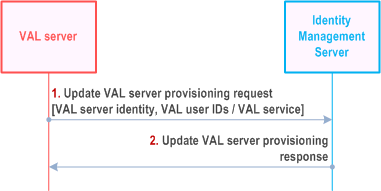
Step 1.
The VAL server sends a request message to identity management server to update the required provisioning information. The request message includes identity of the VAL server, security credentials of the VAL server, and service provider specific information like identity list per VAL service.
Step 2.
Upon receiving the request, the identity management server authorizes the request based on the security credentials provided in the request and considering the service level agreement between VAL service provider and SEAL service provider. If VAL server is authorized to use the SEAL service and if there exists provisioning information, then the identity management server updates the details about the VAL server for the provided VAL service IDs, including the list of VAL user IDs per VAL service. The provisioning information corresponding to a VAL server ID can be updated to add, remove or update VAL service IDs and its related information. The identity management server sends the response message to the VAL server.
12.3.4.4 Get VAL server provisioning procedure p. 168
The procedure for VAL server to get the required provisioning information to SEAL identity management server is illustrated in Figure 12.3.4.4-1.
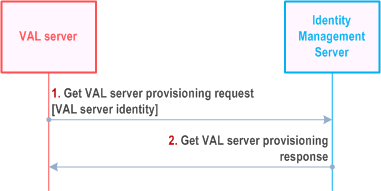
Figure 12.3.4.4-1: VAL Server requesting provisioning information to SEAL Identity Management Server
Step 1.
The VAL server sends a request message to identity management server to get the required provisioning information. The request message includes identity of the VAL server whose provisioning information is requested.
Step 2.
Upon receiving the request, the identity management server authorizes the request based on the security credentials provided in the request and considering the service level agreement between VAL service provider and SEAL service provider. If VAL server is authorized to use the SEAL service and if there exists provisioning information, then the identity management server sends success response including the list of VAL user IDs per VAL service. Otherwise, the identity management server sends failure response message to the VAL server.
12.3.4.5 Delete VAL server provisioning procedure p. 169
The procedure for VAL server to delete the provisioning information to SEAL identity management server is illustrated in Figure 12.3.4.5-1.
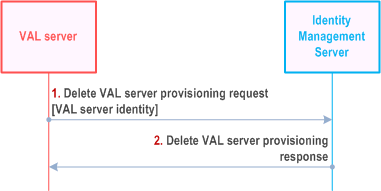
Step 1.
The VAL server sends a request message to identity management server to delete the provisioning information. The request message includes identity of the VAL server.
Step 2.
Upon receiving the request, the identity management server authorizes the request based on the security credentials provided in the request and considering the service level agreement between VAL service provider and SEAL service provider. If VAL server is authorized to use the SEAL service and if there exists provisioning information, then the identity management server deletes the provisioning information for given VAL server ID and sends success response. Otherwise, the identity management server sends failure response message to the VAL server.
12.4 SEAL APIs for identity management p. 169
12.4.1 General p. 169
Table 12.4.1-1 illustrates the SEAL APIs for identity management.
| API Name | API Operations | Known Consumer(s) | Communication Type |
|---|---|---|---|
| SS_ | Provide_Configuration | VAL server | Request/Response |
| Update_Configuration | |||
| Get_Configuration | |||
| Delete_Configuration |
12.4.2 Void
12.4.3 SS_IdmParameterProvisioning API |R18| p. 170
12.4.3.1 General p. 170
API description:
This API enables the VAL server to provision configuration for the VAL service to the SEAL IM-S.
12.4.3.2 Provide_Configuration operation p. 170
API operation name:
Provide_Configuration
Description:
Provisioning of VAL service configuration to IM-S.
Known Consumers:
VAL server.
Inputs:
Outputs:
See subclause 12.3.4.2 for the details of usage of this API operation.
12.4.3.3 Update_Configuration operation p. 170
API operation name:
Update_Configuration
Description:
Updating the provisioning of VAL service configuration to IM-S.
Known Consumers:
VAL server.
Inputs:
Outputs:
See subclause 12.3.4.3 for the details of usage of this API operation.
12.4.3.4 Get_Configuration operation p. 170
API operation name:
Get_Configuration
Description:
Get provisioning of VAL service configuration from IM-S.
Known Consumers:
VAL server.
Inputs:
Outputs:
See subclause 12.3.4.4 for the details of usage of this API operation.
12.4.3.5 Delete_Configuration operation p. 170
API operation name:
Delete_Configuration
Description:
Deleting the provisioning of VAL service configuration on IM-S.
Known Consumers:
VAL server.
Inputs:
Outputs:
See subclause 12.3.4.5 for the details of usage of this API operation.